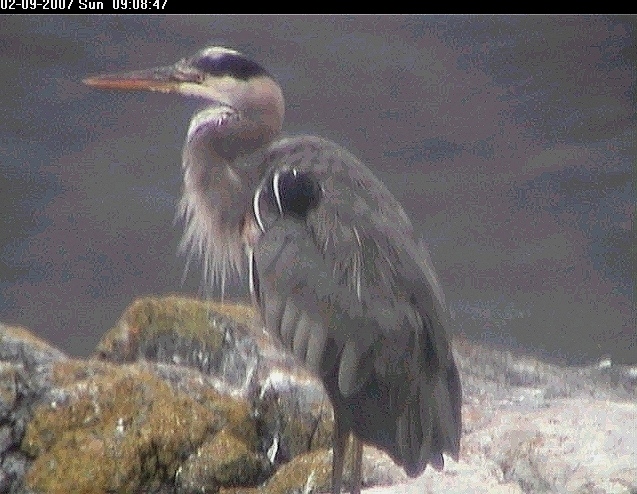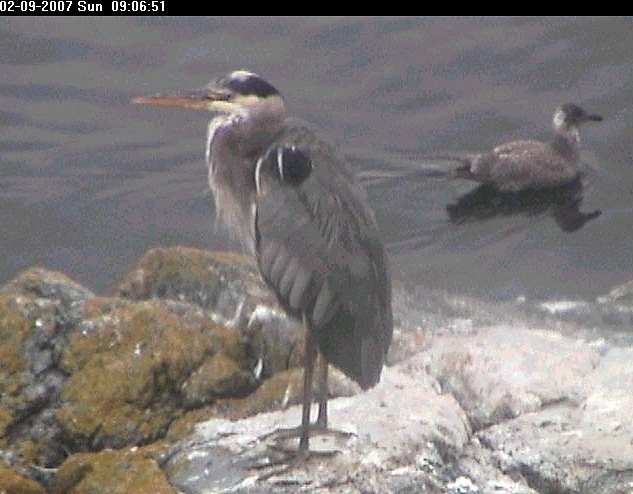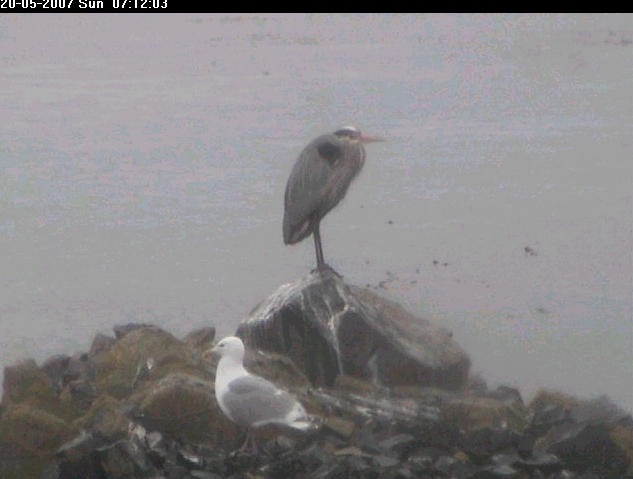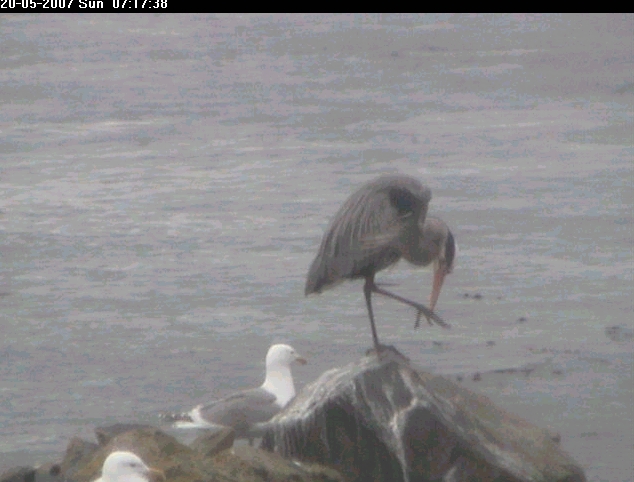- We don’t often see herons at Race Rocks so we were fortunate to have Mike and Carol there to get this picture of one perched on a winch cable. (2005)
- Note tthe yellow eye.
- Finally the Heron roosts close enough to the camera to get a good image. Sept 2, 2007 (Photos by PB.)
- We don’t often see herons at Race Rocks so we were fortunate to have Mike and Carol there to get this picture of one perched on a winch cable. (2005)
- May 20, 2007. This Heron spent some time on Race Rocks
- Itchy bill?? Remote cam 5 photos by PB.
- Heron standing on kelp on the north side of Great Race Rocks August 23, 2007:
Images for this slide show video were taken on the remote camera 5 by PB.
The great blue heron is a very widely spread bird throughout the American continent. During the breeding season it can be found in places such as Alaska and as far south as Mexico or the West Indies. In Winter, most blue herons leave Canada and go to the United States, or even places as Panama, Colombia and Venezuela. However, British Columbia seems to be an exception to this, and blue herons live there during the whole year. On the southern part of Vancouver Island, they are frequent residents in Pedder Bay and are often seen sitting out on the kelp at Rocky Point. Kelp provides shelter for a number of small fish such as herring and anchovie. Occasionally on calm days, we will see a heron standing and spearing fish from the Nereocystis (kelp) beds out at Race Rocks, so they become part of the top of the food web in the ecosystem.
Blue herons are the biggest type of heron. Adults can be over 1 meter tall, and they can have a 2 meter wing span. Their head is white with a black stripe on each side extending back from the eyes. Their back is blue and the breast is white streaked with black. In flight, the neck is doubled back and the head rests against the shoulders. Herons in their first year have grey crowns and grey wings.
Great blue herons feed mainly on very small fish, with no more then 7cm of length. Occasionally, they can feed on shellfish, insects, amphibians, reptiles, small birds and rodents.
Blue herons usually nest in forest areas, within a few kilometres from their main feeding area, in treetops. This is done in order to prevent the nest from being reached by land predators. During the spring, when both males and females arrive for nesting, males occupy old nests or branches and prepare to defend their territory. In the presence of females, they emit very loud shrieks. Two year old males are the most likely to mate immediately. The closest possible nesting area to Race Rocks is Rocky Point.
After mating, males gather construction materials to build a new nest, and together with the female, they build it in about one week. By April, each female then lays three to five eggs, which she incubates during the night, while the male incubates them during the day.
After hatching, young herons are fed by their parents, who regurgitate predigested food. If supplies are not enough. Only the strongest will survive. The weaker offspring end up being pushed out of the nest by the strongest, and they eventually starve. The survivors grow very quickly. Eight weeks after they’re born they can already fly clumsily, and at the age of ten weeks they leave the nest and become independent. An average of two or three chicks results from each breeding cycle of the blue heron
Great blue herons are a very sociable species. They organize in colonies for breeding, feeding and protection from predators.
These birds live as long as 17 years. They have very few natural predators. Draining marshes and destroying common food sites are the greatest threat to the population of great blue herons. However, the mortality among young birds is high. The eggs are often preyed upon by crows, ravens, eagles and raccoons. In ictoria, nesting colonies have moved due to continula predation by bald eagles. Shortage of food is also a common death factor among youngsters. Although contamination by chemicals seems to interfere with the reproductive system, it is not yet proven that it has a direct impact on overall population levels.
Reference: Hinterland Who’s Who?
Domain Eukarya
Kingdom Animalia
Phylum Chordata
SubphylumVertebrata
Class Aves
Order Ciconiiformes
Family Ardeidae
Genus Ardea
Species herodias
Common Name: Great Blue Heron
|
Other Members of the Class Aves at Race Rocks.
|
and Image File |
 The Race Rocks taxonomy is a collaborative venture originally started with the Biology and Environmental Systems students of Lester Pearson College UWC. It now also has contributions added by Faculty, Staff, Volunteers and Observers on the remote control webcams. March 8 2009- Pam Birley The Race Rocks taxonomy is a collaborative venture originally started with the Biology and Environmental Systems students of Lester Pearson College UWC. It now also has contributions added by Faculty, Staff, Volunteers and Observers on the remote control webcams. March 8 2009- Pam Birley |








